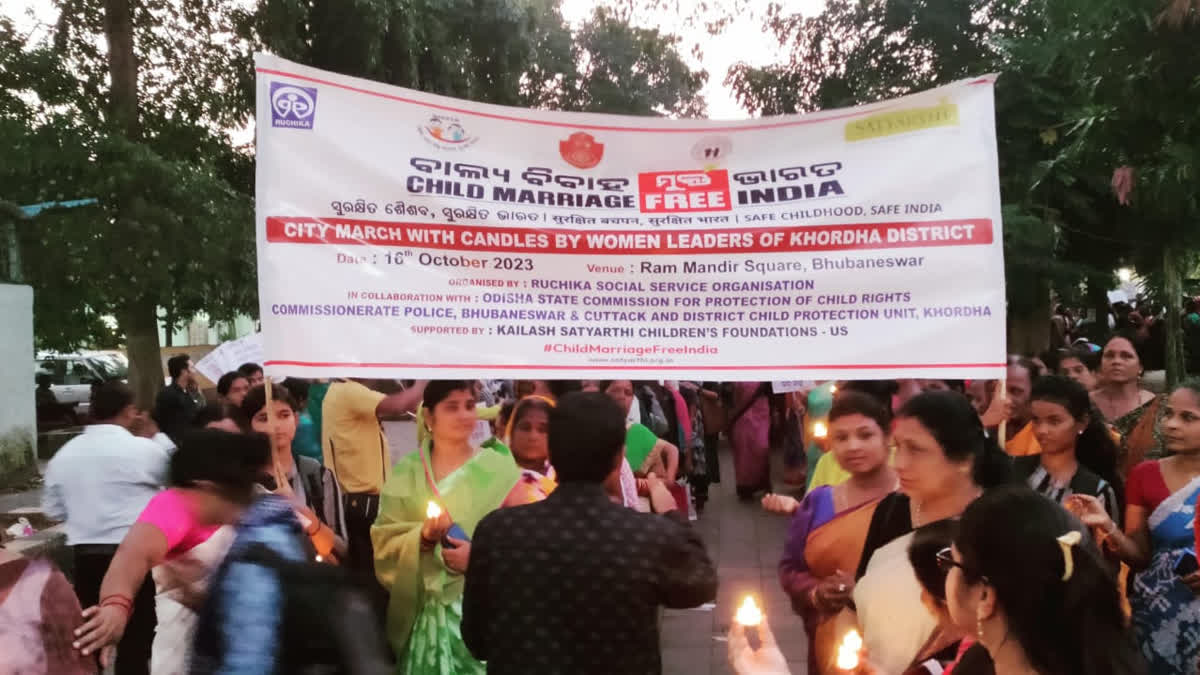Bhubaneswar: All of 16 years, Priya was at the altar of her parents' desire to 'secure her future' . They wanted to marry her off. The house was painted, decoration almost over, feasting had already begun among the neighbors and relatives were waiting to see her on the wedding mandap. Averse to getting into wedlock at her age, she tried convincing he parents but her attempts never yielded results. She was also not the one to give up on her dreams and aspirations.
A few hours before her marriage, she ran away and knocked the doors of a not-for-profit organisation to stop her marriage. They stepped in and stopped her marriage. Today, Priya is considered the harbinger of change. She has been continuing her education and also working as a brand ambassador of Saji Child Marriage Awareness and a role model for girls across Odisha. She is actively involved in raising awareness about child marriage.
Child marriage remains an unfortunate reality in many parts of India, including Odisha. National statistics reveal that 23% of girls in the country are married before reaching the legal age of 18. Odisha, though making strides in awareness, still grapples with a 20% child marriage rate, with districts like Rayagada (39%) and Nayagarh (36%) reporting alarming numbers. Poverty, lack of education, and deep-seated societal norms continue to fuel this practice, robbing children—particularly girls—of their childhood, health, and opportunities.
The reasons for child marriage are manifold. In some cases, families marry off their daughters early to avoid the perceived “shame” of relationships formed during adolescence. In others, financial burdens or societal pressures push parents to act against their own better judgment. For many young girls, this results in a lifelong struggle with health issues, disrupted education, and emotional trauma.
A Defiant Voice: Priya’s Story
Priya’s story is just one of the many girls who are made to accept the choices their parents make out of desperation or to get rid of the 'burden' these girls are often tagged as. Priya's family had fixed her marriage to a manager at a delivery company, believing it was the best possible option for her that can secure her future. But Priya wanted to complete basic education and also aspired to become self-reliant. So she refused to comply.
Since her parents did not pay heed to her protests, she took matters into her own hands. She approached a local women’s rights organization and sought their help to garner support. With the intervention of activists and local authorities, her marriage was called off just a day before the ceremony. Today, Priya has resumed her studies and is actively involved in raising awareness about child marriage. Now she has become a brand ambassador for Saji Child Marriage Awareness and a role model for girls across Odisha.
“When I look back, I see how close I came to losing my dreams,” says Priya. “But standing up for myself has given me the strength to fight for others. No girl should have to sacrifice her future like this.”
In this regard, Odisha State Commission For Protection Of Child Rights (OSCPCR) Head, Mandakini Kar said, "No one can deny that child marriages are not happening. Since the number of dropouts in schools is increasing, the rate of child marriage is commensurately rising. . We have set a target of 2030 for the entire country to be free from child marriages." However, she says, the situation is much better in Odisha. "People are aware these days and sending their children to school. Since earlier they were not aware of the law, now they are exercising caution," she explains, ading that poverty is one of the major reasons why parents want to give away the daughters in marriage early in life.
Petitioners against child marriage
Shocked by a 2017 incident in Ganjam district, where a minor girl’s wedding was proceeding unchecked, Alka Sahu, a social worker from Odisha who has dedicated her life to eradicating child marriage, filed a petition in the Supreme Court, demanding stricter measures to combat child marriage. Her efforts culminated in a historic Supreme Court guideline mandating accountability at every level—from sarpanchs to district magistrates—to prevent child marriages. The guidelines introduced a systematic approach, including the appointment of Child Marriage Prohibition Officers (CMPOs) in every district, special juvenile police units under district SPs, and awareness campaigns targeting schools and villages.
“The battle against child marriage is not just legal but deeply social,” says Alka. “It’s about changing mindsets and creating an environment where every child can dream without fear.”
The Ministry of Women and Child Affairs and the Ministry of Home Affairs will have the details of status of child marriage in the state once in every three months, said Kar. "The data will be updated on the website. The District Collector and SP will be the accountable officers in this regard. A Special Juvenile Police Unit will be set up under the supervision of the SP to prevent child marriage. Along with this, there will be a Child Marriage Provision Unit in the state which will have the CMPOs of the state, five social workers including two women, at the district level, which will monitor and investigate the complaints regarding child marriages," stated Kar.
Government Initiatives and Achievements
Thanks to concerted efforts by activists, NGOs, and the government, Odisha is making progress. Over the past three years, 1.7 lakh child marriages have been successfully stopped across the country, and more than 50,000 villages declared child marriage-free.
The Odisha government has set an ambitious target to make the state child marriage-free by 2030. Their efforts include:
• Special Monitoring Units: Dedicated teams under district SPs work exclusively to prevent child marriages.
• Awareness Campaigns: Programs at the panchayat, school, and village levels educate communities about the consequences of child marriage.
